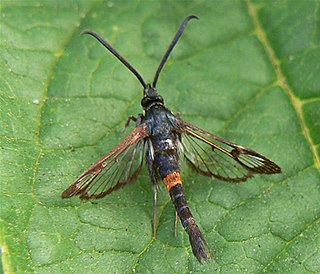Related Research Articles

Synanthedon culiciformis, known as the large red-belted clearwing, is a moth of the family Sesiidae. It is found in the Palearctic and Nearctic realms.

Synanthedon myopaeformis is a moth of the family Sesiidae and the order Lepidoptera. In Europe it is known as the red-belted clearwing and in North America as the apple clearwing moth. The larvae create galleries under the bark of fruit trees, especially old trees with damaged trunks. During this process, the larvae cause significant damage to host trees. Particular attention has been paid to the damage they cause to apple trees. Their status as a pest of apple orchards has led to many research projects aimed at controlling populations of the moth. This moth is native to Europe, the Near East and North Africa. Recently, the moth was introduced into North America, being first detected in Canada in 2005. There are several organisms that threaten the larvae, including parasitoids, nematodes, and bacteria.

Synanthedon tipuliformis, known as the currant clearwing, is a moth of the family Sesiidae. It is endemic to the Palearctic realm, but is an invasive species in the Nearctic realm and the Australasian realm.

Synanthedon is a genus of moths in the family Sesiidae.
Synanthedon andrenaeformis, the orange-tailed clearwing, is a moth of the family Sesiidae. It is known from most of Europe. It is also present in the Near East.

Synanthedon scitula, the dogwood borer or pecan borer, is a moth that is a pest of many plants including the dogwood and pecan. It is notorious due to the severity of damage it can cause and its widespread geographical distribution.

Synanthedon rileyana, the horsenettle borer or Riley's clearwing moth, is a moth of the family Sesiidae. It is found in the United States, including Arkansas, Arizona, Missouri, Oklahoma, North Carolina and Pennsylvania.
Synanthedon beutenmuelleri is a moth of the family Sesiidae. It is known from the Republic of the Congo.
Carmenta chromolaenae is a moth of the family Sesiidae. It is native to Venezuela, but was introduced to South Africa for the biological control of Siam weed.
Synanthedon monozona is a moth of the family Sesiidae. It is known from South Africa.
Synanthedon platyuriformis is a moth of the family Sesiidae. It is known from South Africa.
Synanthedon pyrethra is a moth of the family Sesiidae. It is known from South Africa.
Synanthedon rhodia is a moth of the family Sesiidae first described by Herbert Druce in 1899. It is known from South Africa.
Synanthedon gabuna is a moth of the family Sesiidae. It is known from Gabon.
Synanthedon nuba is a moth of the family Sesiidae. It is known from the Republic of the Congo and Gabon.
Synanthedon pauper is a moth of the family Sesiidae. It is known from Cameroon.
Chamanthedon elymais is a moth of the family Sesiidae first described by Herbert Druce in 1899. It is known from Mozambique and South Africa.

Synanthedon formicaeformis, the red-tipped clearwing, is a moth of the family Sesiidae and can be found in all of Europe, the eastern Palearctic realm, and the Near East. The larvae sometimes form pear-shaped galls on willows. It was first described by Eugenius Johann Christoph Esper in 1783.

Synanthedon stomoxiformis is a moth of the family Sesiidae. It is found in most of Europe and the Middle East.

Synanthedon scoliaeformis, the Welsh clearwing, is a moth of the family Sesiidae. It is found from almost all of Europe, east through Russia to Japan.
References
- ↑ De Prins, J. & De Prins, W. (2017). "Synanthedon alenicum (Strand, 1913)". Afromoths. Retrieved March 30, 2018.